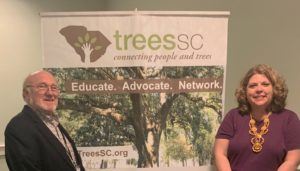Questions about tree trimming and the law can be complicated, McDaniel tells group
 It’s not often that we get to experience “full circle” moments in life, but Kathleen McDaniel recently experienced a wonderful moment, connecting professionally with friends and co-workers from her life before the practice of law.
It’s not often that we get to experience “full circle” moments in life, but Kathleen McDaniel recently experienced a wonderful moment, connecting professionally with friends and co-workers from her life before the practice of law.
Before Kathleen went to law school, she worked as an environmental educator in the City of Charleston’s Department of Parks and was the director of Keep Charleston Beautiful. Charleston’s Urban Forestry program was in the Department of Parks, and Kathleen’s office was next door to its director, Danny Burbage. They became good friends.
Danny has since retired and is now a board member of Trees SC. The non-profit organization fosters stewardship of South Carolina’s urban and community forests through education, advocacy and networking. In another “full circle” moment, the person who took Kathleen’s place with Keep Charleston Beautiful, Karen Hauck, is now executive director of Trees SC.
This was the third year Danny and Karen have invited Kathleen to speak about tree law to this group of arborists, foresters, parks and public works directors, landscape maintenance firms, and others interested in promoting knowledge about trees.
Kathleen, a founding partner of Burnette Shutt & McDaniel in Columbia, focuses her legal practice on environmental and government law issues that include condemnation, permitting and zoning.
Her presentation this year focused on one of the most contentious topics in tree law: when and how power companies, the Department of Transportation, or cities and counties can trim or cut down trees and vegetation that are either on private property or on a public right of way.
Tree problems trigger massive blackout
The importance of maintaining power lines free of trees and vegetation can be seen in the story of the worst blackout in North American history. At approximately 2 p.m. on August 14, 2003, a high-voltage power line in northern Ohio came into contact with overgrown trees. The line automatically shut down, which normally would have tripped an alarm at the utility company headquarters. But there was a bug in the software running the system, and the alarm never sounded. Before operators realized what was happening, three other lines sagged into trees and switched off, causing other power lines to overload.
This set off a cascade of power failures that rippled across eight northeastern states and parts of Canada. Fifty million people lost power for up to two days. The event resulted in 11 deaths and cost an estimated $6 billion.
Following this massive blackout, Congress enacted the Energy Policy Act of 2005. Part of this law required the Federal Energy Regulatory Commission to set standards for minimum distances between power transmission lines and vegetation.
Tree-trimming rights not unlimited
Despite the importance of keeping power lines clear of vegetation, a utility’s right to maintain vegetation and trim trees is not without controversy. As we have seen in Columbia and Charleston recently, trimming can be extreme and leave trees looking unattractive. Charleston residents became so concerned this spring that the utility company halted all tree trimming until an agreement could be worked out. The Public Service Commission held a special hearing on April 4, 2019, regarding SCE&G’s (now Dominion) procedures for conducting tree trimming. A state senator has introduced legislation that would require a certified arborist to be present any time a utility conducts tree trimming.
Most entities that conduct tree trimming have that right because there is an easement across private property that allows maintenance or because the right to maintain vegetation is within the terms of service between the utility and the customer. But such rights are not unlimited. Tree trimmers work within the easement and cannot exceed the scope of that easement or permission. Otherwise, they could be liable for trespass, negligence, conversion, or inverse condemnation.
The question of whether work is conducted within the scope of an easement or permission is further complicated by arboriculture standards meant to protect the tree. For example, imagine a tree limb hanging over a power line. The utility may have the right to cut limbs within 20 feet of the line. However, the point where the limb attaches to the tree may be more than 20 feet from the line. Generally, it is most healthy to cut a limb where it attaches to another limb or to the tree. A raw cut in the middle of a limb is more likely to cause disease or insect damage.
Answers are not always clear
So, in that case, where should the limb be cut? Exactly at the 20-foot distance within which the utility has express permission to trim, or outside that distance but with more protection for the remaining tree? There is no clear answer. Every situation is highly fact dependent, balancing the rights of the utility, power customers, and the health of the tree.
Disputes regarding utility companies trimming trees is just one type of issue where tree law comes into play. Another situation is where a neighbor’s tree is encroaching onto someone else’s property or dropping dead limbs that could cause damage.
It is in situations like these where the assistance of an attorney with knowledge of tree law is important. Burnette Shutt & McDaniel law firm has that knowledge. Contact us at 803.850.0912 or info@burnetteshutt.law if you have questions about tree law or need guidance on legal issues regarding trees.
For more information about Trees SC, go to http://www.treessc.org/.

